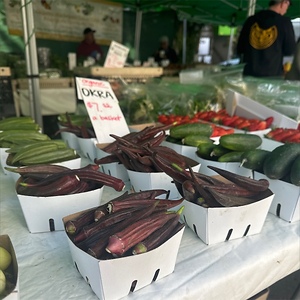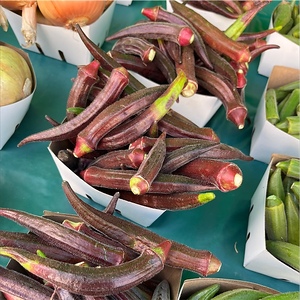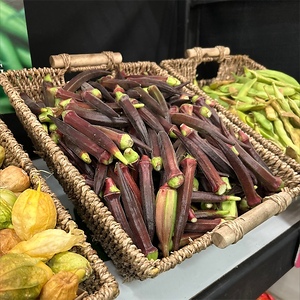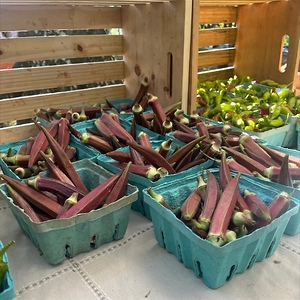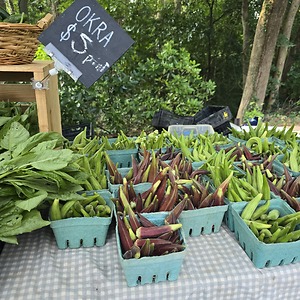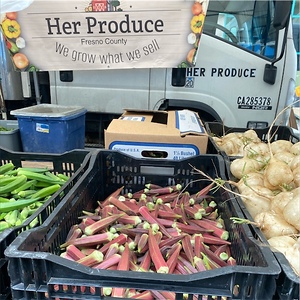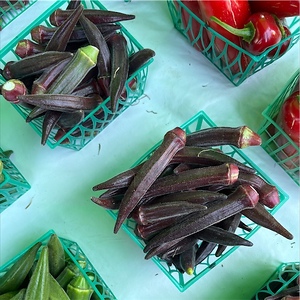


Red Okra
Estimated Inventory, lb : 0
Description/Taste
Red okra is a torpedo-shaped fruit that grows in pods. It comes in different varieties that vary in size, typically measuring 13 to 20 centimeters. At the stem, the pods have a 5-sided shape that tapers to a point at the bottom. This fruit has a deep ruby-red hue that may be patchy and faded in places, revealing varying amounts of bright green splotches depending on the variety. Their stems may also have a ruby-red color with specks of bright green underneath, or vice versa. Red okra has mostly smooth skin with ridges where the walls of the five sides of its pods meet. Its skin is typically shiny but may have a slightly worn appearance due to discoloration. Slicing Red okra in half reveals a creamy white flesh with a structure similar to a snap pea. There is a line down the center of the flesh with pearl-like white seeds on either side. When this variety is chopped crosswise rather than lengthwise, it forms star-shaped pieces that resemble sliced jalapeños. The flesh of Red okra contains mucilage, giving it a thick and slimy texture. This fruit has a fresh taste that is somewhere between eggplant and asparagus. When cooked, its red color disappears and the pods turn green.
Seasons/Availability
Red okra is available in late spring and summer.
Current Facts
Red okra is known botanically as Abelmoschus esculentus and belongs to the Malvaceae family. It's classified as a fruit rather than a vegetable and is often referred to as Red Burgundy, Purple, or Magenta okra. Red okra is often used as an ornamental plant due to its large, long-stemmed yellow flowers, heart-shaped leaves, and thick woody stem. Growing over a meter tall, its flowers resemble those of the hibiscus, as both hibiscus and okra belong to the Malvaceae family. Red okra pods develop in the leaf axil of the plant and grow rapidly after flowering. This fruit comes in many different varieties, including the Baby Bubba, Royal Burgundy, Little Lucy, Red Velvet, Bowling Red Okra, and Aunt Hettie’s Red. Both red and green okra are frequently used in culinary preparations, particularly in the American South.
Nutritional Value
Red okra is a source of antioxidants, including vitamins A and C. These vitamins are beneficial for vision, immune function, cell growth, collagen production, iron absorption, wound healing, cardiovascular health, and protection against free radical damage. The fruit provides the body with potassium and calcium to encourage muscle and nerve function, fluid balance, blood pressure regulation, blood clotting, hormone secretion, and bone health. Red okra contains fiber, promoting digestion, blood sugar control, gut and colon health, and nutrient absorption. Red okra also possesses a protein called lectin that may protect the body against pathogens and harmful bacteria growth.
Applications
Red okra can be blanched, boiled, steamed, deep-fried, braised, sautéed, pickled, or eaten raw. It can be incorporated into all the same recipes as green okra and will turn green when cooked. This fruit is not usually eaten fresh out of hand but can be thinly sliced into salads. It’s frequently incorporated into gumbo, a popular stew from the American South that contains celery, bell peppers, onions, meat, and shellfish. Red okra can also blend well with vegetable soups, pilafs, African stews, and Indian curry dishes like Bhindi Masala and Vendakkai Sambar. It can be deep-fried in cornmeal, diced into cornbread muffins, or used as a unique topping for pizza. Complementary flavors include tomatoes, corn, green beans, zucchini, yams, squash, beans, kale, collard greens, lamb, oysters, crab, shrimp, cumin, coriander, parsley, mint, garlic, lemon juice, and red wine vinegar. To avoid a slimy texture, Red okra should not be washed until it’s ready to prepare. It can be wrapped in plastic and refrigerated for up to 4 days.
Ethnic/Cultural Info
Red okra is a colorful variation of the original green okra. This green variety is synonymous with the cuisine of the American South despite originating from Africa. One of the most popular uses for okra is in gumbo, which coincidentally is the term used for okra in the West African dialect of the Bambara ethnic group. Both okra and the Bambara people arrived in Louisiana during the time of the transatlantic slave trade. Many of those enslaved were transplanted to plantations because of the rice cultivation techniques they practiced in West Africa. At the time, rice consumption was on the rise in Louisiana because it could feed large populations. French immigrants entering the state brought the culinary tradition of roux, a mixture of flour and fat that serves as a thickening agent for soups. These French and West African cooking traditions came together to create the recipe for gumbo that became popular in the early 1800s.
Geography/History
Red okra is a relatively new variation of green okra, which is native to Africa and has existed for over a century. Okra traveled from Africa to the Middle East and India, where it is now commonly used in their cuisines. The fruit was brought to Brazil in the mid-1600s and likely made its way to modern-day Louisiana during the time of slave trade in the New World. The Red okra variety was developed by Leon Robbins at Clemson University in the early 1980s and became an All-American Selections winner by 1988. Unlike its green counterpart, Red okra is a cultivated breed that’s not found growing naturally in the wild. It flourishes in gardens and commercial settings with warm, humid weather, moist soils, and full sun exposure. Red okra is not as readily available as the green variety. It may be found at farmers’ markets in the American South, particularly during its peak summer season, or planted from seed in home gardens.
Recipe Ideas
Recipes that include Red Okra. One
| Viet World Kitchen |
|
Grilled Okra |
| Spinach Tiger |
|
Roasted Okra, Eggplant and Cherry Tomatoes |



